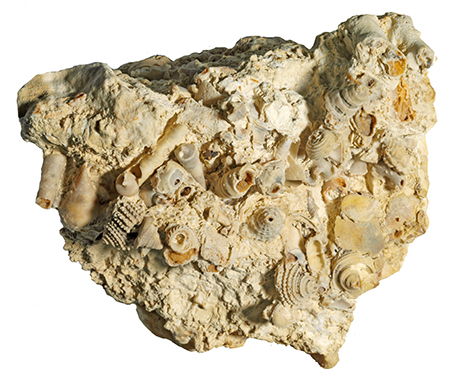June 2024: Upper jurassic reef limestone with snails
Upper Jurassic
ca. 150 million years
Saal an der Donau, near Kehlheim

The quarry near Saal an der Donau opens up fossil-rich Upper Jurassic reefal limestones. The age of the limestones falls into the Middle to Upper Kimmeridgian, i.e. around 150 to 146 million years. The massive limestones reach a thickness of around 100 metres. They are quarried by the Fels-Werke GmbH. The reefal limestones were mainly formed by corals and algae that lived in what was then a warm tropical sea. The limestones contain numerous mussels, snails, crabs, brachiopods and other invertebrates. Just as in today’s tropical reefs, this reef from the Upper Jurassic provided a home for numerous animal species.
Then as now, tropical reefs are the most species-rich marine ecosystems. The quarry in Saal was collected by a number of private collectors over many years. Through purchases and donations, numerous specimens came into the possession of the Bavarian State Collection of Palaeontology and Geology and were scientifically processed. Up to 400 species have been recognised from the coral limestones of Saal. This makes this quarry one of the most species-rich sites in the Upper Jura.
The scientific identification of fossils is often difficult due to insufficient preservation. With around 180 species, snails are the most species-rich and diverse group. This is also reminiscent of today’s tropical seas, in which snails are among the most diverse animal groups.
The fossil of the month, which was found by collector F. Lang, exhibits about 20 snail shells representing around ten species. The pieces are beautifully weathered and comparatively well preserved. One of the species is Planiturbo validotuberosus, which has a striking ornament of spine-like nodes. This species was described as new in 2017 by J. Gründel and colleagues. The holotype of this species (inventory number SNSB-BSPG 2016 IV 37, the specimen on which the species was defined) can be seen on the piece (arrow). A total of 45 new gastropod species have been described from the quarry near Saal in recent years. The present rock specimen with the gastropod shells documents the wealth of gastropods in this important fossil site.
Alexander Nützel, München



